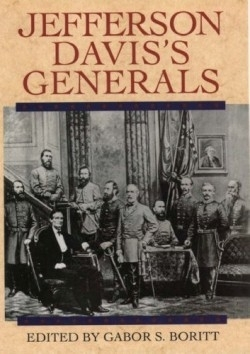Jefferson Davis's Generals
War leaves nothing untouched. This is made obvious in Jefferson Davis’s Generals, a collection of essays from eight renowned Civil War historians that illustrates, primarily, how war affects personal relationships in the military sphere and how these relationships might have affected the outcome of the war. These historians examine the relationships and lives of five important generals, their wives, and their commander in chief, Jefferson Davis.
No singular relationship between Davis and one of his generals can be blamed for the ultimate defeat of the Confederacy, yet, many of these historians admit that personality differences, pride, confusion, miscommunication and simple lack of ability enabled collective failure. Some personal favoritism that Davis showed to some generals and withheld from others may have affected how quickly military orders were implemented. Small hesitations in leadership might have caused fragile alliances to falter within the army of soldiers. The overriding message of these essays is that the Confederacy’s “manpower pool for top-level commanders was too scanty” and that some generals, such as Braxton Bragg, lacked the ability to immediately react to important situations or to inspire admiration and respect. Also, Davis repeatedly “failed to grasp the importance of unified command.”
The two most intriguing chapters examine the effect of the war upon the relationships between the five generals and their wives and the public image of Jefferson Davis as commander in chief at different points during the War. Johnston, Bragg, Hood and Davis drew strength and comfort from their wives. Despite illness and pregnancy, these women followed their husbands. They were confidants and advisors in addition to their domestic duties. Lee and Beauregard, however, had wives that either could not or would not travel with their husbands. The five generals? wives were in two distinct groups: those who traveled and were devoted to their husbands and to the cause of the War and those who stayed at home and were neglected by their husbands.
Harold Holzer illustrates how Jefferson Davis came to “symbolize the Confederacy itself” through the publication of his portrait throughout the war. At the outset of war, Davis was portrayed as a military leader—strong and determined in both Southern and Northern publications. By the time Lee surrendered, Davis was a bumbling Southern aristocrat attempting escape in his wife’s clothing. All prints of Davis during this time were meant to affect the public’s perception of the South: as a strong, military force or, in defeat, as a joke.
Gabor S. Boritt’s introduction is essential in understanding the purpose of this collection because these essays are academic and specific. He includes a helpful annotated bibliography for further reading. This collection is intended for the reader wishing to learn more about the interpersonal relationships of Davis and his top ranking military leaders.
Reviewed by
Kristin Putchinksi
Disclosure: This article is not an endorsement, but a review. The publisher of this book provided free copies of the book to have their book reviewed by a professional reviewer. No fee was paid by the publisher for this review. Foreword Reviews only recommends books that we love. Foreword Magazine, Inc. is disclosing this in accordance with the Federal Trade Commission’s 16 CFR, Part 255.

